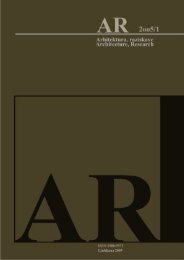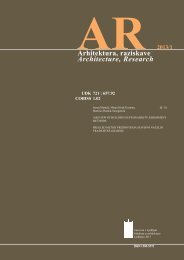VeÄ - Fakulteta za arhitekturo - Univerza v Ljubljani
VeÄ - Fakulteta za arhitekturo - Univerza v Ljubljani
VeÄ - Fakulteta za arhitekturo - Univerza v Ljubljani
You also want an ePaper? Increase the reach of your titles
YUMPU automatically turns print PDFs into web optimized ePapers that Google loves.
4.6. DRUŽBENE ZGRADBE II PUBLIC BUILDINGS 2<br />
IV. letnik 60 ur<br />
prof. dr. Miloš Bonèa, univ. dipl. inž. arh.<br />
- Pevsner, N.: A History of Building Types; Thames and Hudson, London 1979<br />
- Murray, P.: The Arhitecture of Italian Renaissance; Thames & Hudson, London 1986<br />
- Wittkover, R.: Arhitectural Principles in the Age of Humanism; Academy Editions, London 1988<br />
- Summerson, J.: The Classical Language of Architecture; Thames & Hudson, London 1988<br />
- Tafuri M.: The Sphere and the Labyrinth, MIT Press, Cambridge 1990<br />
- Gombrich E.-Eribon D.: Looking for Answer, Conversations on Art and Science; Harry N. Abrams Inc., NY 1993<br />
- Bonèa, M.: Pet vaj iz arhitekture ali arhitekturna razprava o hiši; FA, Ljubljana 1995<br />
- http://www.arh.uni-lj.si/program/dodiplomski/dz2<br />
- Morgan, Conway Lloyd: Jean Nouvel: The Elements of Architecture, Universe Publishing, NY 1998<br />
- Van Berkel, B., Bos, C.: Move: 1. Imaginations, 2. Techniques, 3. Effects; UN Studio & Goose press, Amsterdam 1999<br />
- Baudrillard, J., Nouvel, J.: The Singular Objects of Architecture; University of Minnesota Press, Minneapolis 2002<br />
- Spletni gradbeni vodnik, http://gcs.gi-zrmk.si/3-vodnik/gc_v03.htm, 15.1.2003<br />
- Veljavni pravilniki in <strong>za</strong>koni pri projektiranju v RS, http://www.arhiforum.com/literatura1.html, 15.1.2003<br />
Osnovni smoter predmeta je vzporedno dograjevanje osnov – projektne in strukturne filozofije <strong>za</strong> posamezne vrste zgradb, z vzpostavljanjem<br />
odnosov v širšem prostoru. Vsebina: 1. Hiša je tehniško urejena celota: Anali<strong>za</strong> znaèilnih tipov zgradb (… do multifunkcionalnih mega zgradb, ki se<br />
sproti prilagajajo novim dejavnostim), spoznavanje arhitekturne teme. Organi<strong>za</strong>cija prostora, uporabnost zgradbe, logièna, z metodo podprta<br />
razporeditev programa <strong>za</strong>gotavlja, da bo zgradba najbolje služila svojemu namenu (… do zgradb, kjer se program stalno spreminja). Sestava<br />
zgradbe, materiali in njihova svojstva, konstrukcijske izkušnje, transformirane v <strong>arhitekturo</strong>, delitev na nosilni in loèilni sistem omogoèa novo<br />
razumevanje fasadnega pasu (… do integralnih površin, ki združujejo funkcijo, infrastrukturo in konstrukcijo). 2. Hiša je del mesta (graditi hišo je<br />
kulturno dejanje): Odnos med hišo in mestom, temeljne arhitekturne naloge v zgodovinskih obdobjih, mestna palaèa – javni svet mesta, privatni svet<br />
uporabnikov, naravni svet vrtov. Hiša, ki doloèa mesto – 19. stoletje v <strong>Ljubljani</strong> – veliki volumni, novo veliko merilo, nove ambientalne poteze, razvoj<br />
novih tipov zgradb. Odnos med obstojeèim in novim, prenova kot aktivna <strong>za</strong>šèita, znaèilni primeri povojne prenove mestnih jeder v Evropi. Odnos<br />
med zgradbo in okoljem, znaèilni posegi, klasifikacija posegov, metode. Prouèevanje okolja – sistematièna ureditev elementov na nivoju ambienta,<br />
objekta, detajla, ob spoštovanju zgodovinskega razvoja in lokalnih znaèilnosti. Model uskladitve novega z obstojeèim – razgraditev volumnov na<br />
stalne osnove in spremenljive dodatke (na tehniške in oblikovne enote). Razvoj modela, razslojevanje lupine na <strong>za</strong>šèito objekta in na pove<strong>za</strong>vo z<br />
okoljem - dve plasti (… do novih topoloških prostorskih kontinuitet).<br />
The prime rationale of the course is parallel growth of basic project and structural philosophy for particular types of buildings by establishing<br />
relations in wider space.Contents: The building is a technically arranged entity: Analysis of typical types of buildings (… from multi-functional megabuildings,<br />
that consequentially adapt to new functions), recognition of the architectural theme. Spatial organisation, building utility, logical, method<br />
supported distribution of programmes ensures that the building will serve its purpose (… even buildings, whose programme changes constantly).<br />
Composition of a building, materials and their properties, experiences in construction translated to architecture, separation into load bearing and<br />
dividing systems enables new understanding of the façade belt (… to integral surfaces that join function, infrastructure and construction). The building<br />
is part of the city (building a house is a cultural act): the relation between the building and city, basic architectural tasks in historical periods, the city<br />
palace, city’s public domain, private user’s domain, natural domain of gardens. The house which determines the city … 19 th century in Ljubljana,<br />
large volumes, new grand scales, new ambiances of single strokes, development of new building types. Relation between extant and new, rehabilitation<br />
as active protection and typical examples of post-war rehabilitation of urban cores in Europe. Relation between the building and its’ surroundings,<br />
typical developments, classification of developments, methods. Examining the environment, systematic arrangement of elements on the level of<br />
place, building, detail, with respect to historical development and local specifics. Model for harmonising the new with the extant, decomposition of<br />
volumes into constants and changeable additions (technical and design elements). Development of the model, layering of the envelope into two<br />
layers – protective and connective layer (… unto new topological spatial continuities).<br />
smer: ARHITEKTURA<br />
leto year<br />
01<br />
02<br />
03<br />
04<br />
05<br />
85

















